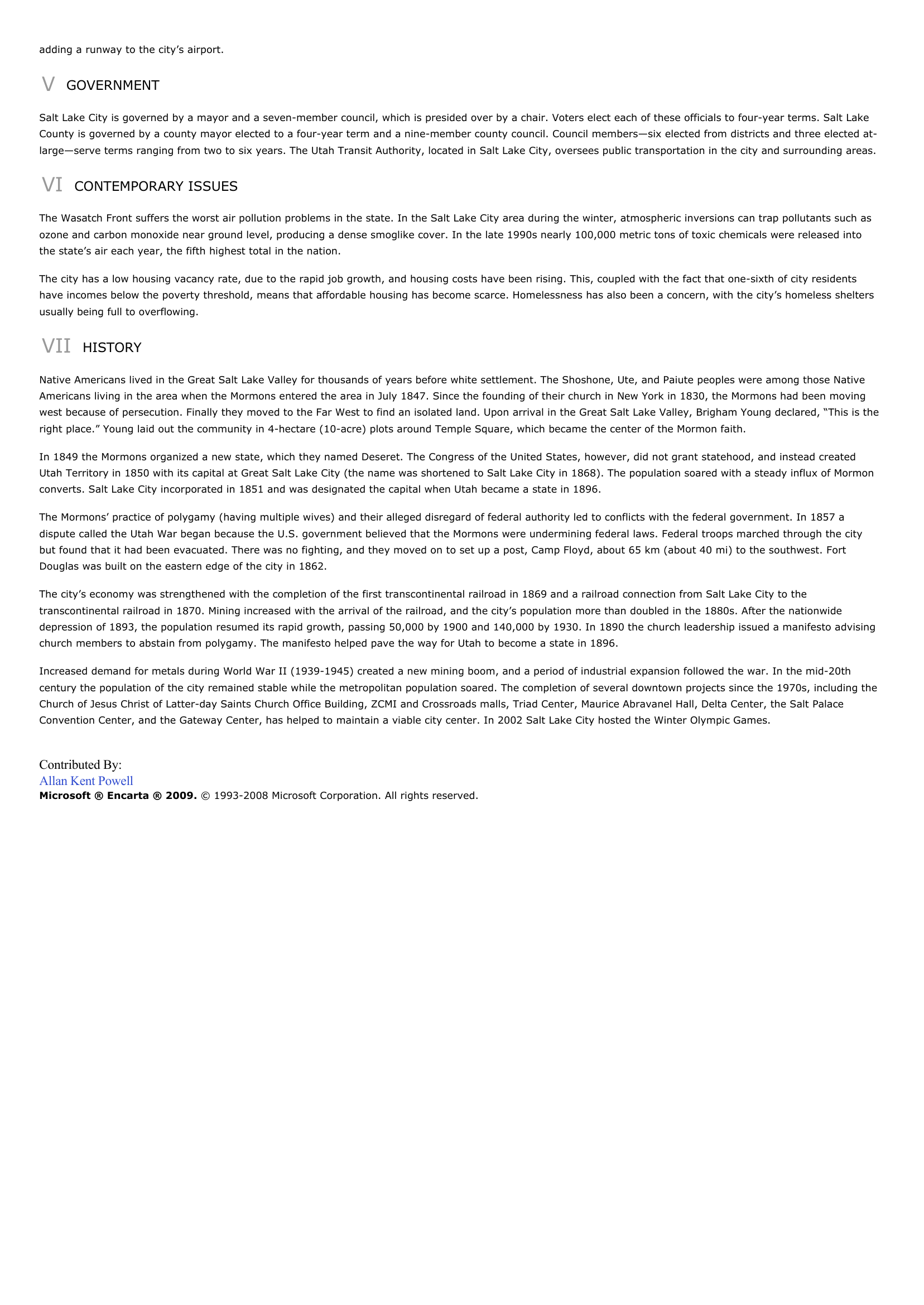Salt Lake City - geography.
Publié le 04/05/2013

Extrait du document
«
adding a runway to the city’s airport.
V GOVERNMENT
Salt Lake City is governed by a mayor and a seven-member council, which is presided over by a chair.
Voters elect each of these officials to four-year terms.
Salt LakeCounty is governed by a county mayor elected to a four-year term and a nine-member county council.
Council members—six elected from districts and three elected at-large—serve terms ranging from two to six years.
The Utah Transit Authority, located in Salt Lake City, oversees public transportation in the city and surrounding areas.
VI CONTEMPORARY ISSUES
The Wasatch Front suffers the worst air pollution problems in the state.
In the Salt Lake City area during the winter, atmospheric inversions can trap pollutants such asozone and carbon monoxide near ground level, producing a dense smoglike cover.
In the late 1990s nearly 100,000 metric tons of toxic chemicals were released intothe state’s air each year, the fifth highest total in the nation.
The city has a low housing vacancy rate, due to the rapid job growth, and housing costs have been rising.
This, coupled with the fact that one-sixth of city residentshave incomes below the poverty threshold, means that affordable housing has become scarce.
Homelessness has also been a concern, with the city’s homeless sheltersusually being full to overflowing.
VII HISTORY
Native Americans lived in the Great Salt Lake Valley for thousands of years before white settlement.
The Shoshone, Ute, and Paiute peoples were among those NativeAmericans living in the area when the Mormons entered the area in July 1847.
Since the founding of their church in New York in 1830, the Mormons had been movingwest because of persecution.
Finally they moved to the Far West to find an isolated land.
Upon arrival in the Great Salt Lake Valley, Brigham Young declared, “This is theright place.” Young laid out the community in 4-hectare (10-acre) plots around Temple Square, which became the center of the Mormon faith.
In 1849 the Mormons organized a new state, which they named Deseret.
The Congress of the United States, however, did not grant statehood, and instead createdUtah Territory in 1850 with its capital at Great Salt Lake City (the name was shortened to Salt Lake City in 1868).
The population soared with a steady influx of Mormonconverts.
Salt Lake City incorporated in 1851 and was designated the capital when Utah became a state in 1896.
The Mormons’ practice of polygamy (having multiple wives) and their alleged disregard of federal authority led to conflicts with the federal government.
In 1857 adispute called the Utah War began because the U.S.
government believed that the Mormons were undermining federal laws.
Federal troops marched through the citybut found that it had been evacuated.
There was no fighting, and they moved on to set up a post, Camp Floyd, about 65 km (about 40 mi) to the southwest.
FortDouglas was built on the eastern edge of the city in 1862.
The city’s economy was strengthened with the completion of the first transcontinental railroad in 1869 and a railroad connection from Salt Lake City to thetranscontinental railroad in 1870.
Mining increased with the arrival of the railroad, and the city’s population more than doubled in the 1880s.
After the nationwidedepression of 1893, the population resumed its rapid growth, passing 50,000 by 1900 and 140,000 by 1930.
In 1890 the church leadership issued a manifesto advisingchurch members to abstain from polygamy.
The manifesto helped pave the way for Utah to become a state in 1896.
Increased demand for metals during World War II (1939-1945) created a new mining boom, and a period of industrial expansion followed the war.
In the mid-20thcentury the population of the city remained stable while the metropolitan population soared.
The completion of several downtown projects since the 1970s, including theChurch of Jesus Christ of Latter-day Saints Church Office Building, ZCMI and Crossroads malls, Triad Center, Maurice Abravanel Hall, Delta Center, the Salt PalaceConvention Center, and the Gateway Center, has helped to maintain a viable city center.
In 2002 Salt Lake City hosted the Winter Olympic Games.
Contributed By:Allan Kent PowellMicrosoft ® Encarta ® 2009. © 1993-2008 Microsoft Corporation.
All rights reserved..
»
↓↓↓ APERÇU DU DOCUMENT ↓↓↓
Liens utiles
- Salt Lake City - geography.
- Salt Lake City.
- Borzage Frank, 1893-1962, né à Salt Lake City, cinéaste américain.
- Borzage (Frank) Metteur en scène de cinéma américain (Salt Lake City, 1893 - Hollywood, 1963).
- États-Unis. Salt Lake City, le Capitole.





